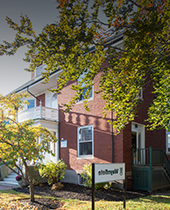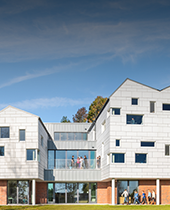
Early Childhood
Program
In Waynflete classes, students start to solve new problems by asking themselves two questions: What do I notice? What do I wonder?
Our dedicated teachers know there are many ways to arrive at a right answer and that students learn best when they find and follow their own path. That’s why we encourage the keen observations, creative leaps, hands-on experimentation, and rigorous thinking that lead to inventive solutions and rich insights—and make active learners for life.
Early Childhood Language Arts
Listening
- enjoy stories, poetry, rhyming, and playing with sounds of language,
- listen and respond appropriately to others,
- follow multistep directions,
- match letters to sounds, and
- hear and remember stories and other information.
Speaking
- exhibit ability to verbalize needs,
- recite songs and poetry with the group and/or independently,
- share ideas and experiences,
- dictate stories with a beginning, middle, and end, and
- join discussions with relevant comments and questions.
Reading
- enjoy stories and poetry,
- identify their own names in print,
- begin to identify letter names and sounds, and
- strengthen receptive and expressive vocabulary.
Writing
- express ideas through drawing,
- dictate stories,
- develop fine motor skills,
- develop a functional pencil grip, and
- begin to develop correct letter formation.
Early Childhood Mathematics
Number Sense
- understand that numbers have many uses (e.g., recipes, prices, ages),
- count from 1 to 10,
- begin to recognize numerals and understand what numbers mean (e.g., the numeral 5 stands for five), and
- count using one-to-one correspondence.
Computation
- begin to use varied manipulative materials purposefully, and
- gain experience with and exposure to beginning addition
and subtraction.
Data Analysis
- gather and help organize information, and
- sort and classify objects by attributes.
Geometry
- describe, model, and classify shapes.
Measurement
- gain experience with concepts of length, weight,
and volume.
Patterns and Relationships
- recognize, describe, and create simple patterns, and
- begin to understand calendar concepts.
Math Communications
- express awareness of attributes such as size, shape, and quantity,
- help use a procedural list such as a recipe, and
- begin to print numerals.
Early Childhood Social Studies
- recognize unique individual strengths and explore
family backgrounds, - honor a broad range of diversity,
- understand how members of a community help each other,
- identify and practice rights and responsibilities of group membership, and
- utilize maps, globes, and research materials to learn about and honor traditions from various cultures.
Early Childhood Science
Life Science
- develop appreciation for the environment and learn ways to help preserve it,
- observe and compare different types of plants and animals,
- study the habitats and life cycles of various life forms,
- observe the development of plants over time,
- use science tools such as magnifying glasses to aid observation, and
- investigate how seasonal changes affect living things.
Physical Science
- study the relative properties of various materials through experience with sand, water, play dough, clay, etc.,
- use scales to experiment with and develop the concept
of balancing, - explore magnetism by experimenting with magnets to determine their properties,
- experience physical changes in ingredients during cooking projects,
- design and assemble structures and environments using a variety of natural and man-made materials, and
- study the relationships among light, objects, and shadows.
Early Childhood Visual Arts
Creative Expression
- understand that visual arts may be used to express observations, ideas, understandings, or emotions,
- begin to understand that materials may be chosen for
specific purposes, - draw with a variety of graphic materials,
- paint with tempera, watercolor, and finger paint, demonstrating a variety of marks,
- identify primary, secondary, and neutral colors by name, and experiment with mixing colors,
- begin to explore the concept of uniting small parts to form a larger whole,
- begin to represent people and objects in two and three dimensions with a variety of media, and
- explore light and transparency as vehicles for self-expression.
Aesthetics
- describe their own work, and
- look carefully to notice details.
Arts and Cultural Heritage
- know that all people create art differently, and
- know that art is made from many different materials.
Early Childhood Music
- keep a steady pulse,
- use motions with songs,
- distinguish between high and low pitches,
- match pitches,
- begin to develop head voice,
- experiment with a variety of instruments and sound sources,
- perform simple beats on percussion instruments,
- create songs by combining original words and melodies, and
- include music in creative play.
Creative Movement
- communicate concepts and ideas through movement,
- develop freedom of movement and expression with and without limitations,
- relate movement explorations in the dance space to classroom themes of study,
- develop a sense of physical well-being and flexibility,
- strengthen muscular coordination and motor skills, and
- develop basic locomotor and axial movements in isolation
and combination.
Early Childhood Physical Education
- identify physical changes that occur during vigorous activity,
- perform appropriate warm-up activities,
- engage in moderate to vigorous physical activity,
- learn basic elements of movement,
- move with an awareness of space and others’ safety,
- develop locomotor skills (e.g., running, jumping, galloping),
- build non-locomotor skills (e.g., bending, stretching, rolling),
- improve form with sports equipment (e.g., balls, beanbags, paddles)
- identify the rules of a given activity,
- demonstrate the ability to cooperate with peers, and
- use equipment responsibly.
Early Childhood Health
- demonstrate independence in basic self-help and personal
hygiene skills, - differentiate between safe and harmful substances found at home and school,
- apply coping strategies when feeling overly excited, anxious, or angry, and
- demonstrate healthy ways to express needs, wants, and feelings
THE WAYNFLETE WIRE
Why Reggio Emilia is the right approach to preschool.
What happens when you put three- and four-year-olds in charge of their own learning? They will learn because they want to—for the rest of their lives.See how Waynflete transforms the traditional classroom and engages our youngest learners
CONTACT
“Our EC classroom hums with the work of children—excited and productive play. It is an environment that nurtures experimentation, curiosity, and risk taking. We listen to children’s questions and ideas and design connected and purposeful learning opportunities that encourage deeper inquiry. Come see where they have taken us today!”
Anne Scribner Hopkins
Waynflete Lower School Director



